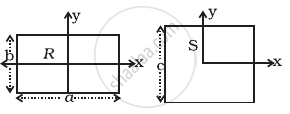Advertisements
Advertisements
प्रश्न
A uniform square plate S (side c) and a uniform rectangular plate R (sides b, a) have identical areas and masses (Figure).

Show that
- IxR/IxS < 1
- IyR/IyS > 1
- IzR/IzS > 1
उत्तर
According to the problem,
Area of square = area of rectangular plate
⇒ `c^2 = a xx b`
⇒ `c^2 = ab`
a. `I_(xR)/I_(xS) = b^2/c^2` ......[∵ I ∝ (area)2]
It is clear from the diagram that b < c
⇒ `I_(xR)/I_(xS) = (b/c)^2 < 1`
⇒ `I_(xR) < I_(xS)`
b. `I_(yR)/I_(yS) = a^2/c^2` ......(It is clear that a < c)
`I_(yR)/I_(yS) - (a/c)^2 > 1`
c. `I_(zR) = 1/12 M(a^2 + b^2)`
`I_(zS) = 1/12 M(c^2 + c^2)`
Now, `I_(zR) - I_(zS) = 1/12 M[a^2 + b^2 - 2c^2]`
= `1/12 M(a^2 + b^2 - 2ab)`
`I_(zR) - I_(zS) = 1/12 M(a - b)^2 > 0`
⇒ `I_(zR)/I_(zS) > 1`
APPEARS IN
संबंधित प्रश्न
Seven homogeneous bricks, each of length L, are arranged as shown in figure. Each brick is displaced with respect to the one in contact by L/10. Find the x-coordinate fo the centre of mass relative to the origin shown.
Consider a gravity-free hall in which a tray of mass M, carrying a cubical block of ice of mass m and edge L, is at rest in the middle. If the ice melts, by what distance does the centre of mass of "the tray plus the ice" system descend?

A block of mass 2.0 kg moving 2.0 m/s collides head on with another block of equal mass kept at rest. (a) Find the maximum possible loss in kinetic energy due to the collision. (b) If he actual loss in kinetic energy is half of this maximum, find the coefficient of restitution.
Consider the situation of the previous problem. Suppose each of the blocks is pulled by a constant force F instead of any impulse. Find the maximum elongation that the spring will suffer and the distance moved by the two blocks in the process.
The speed of the centre of a wheel rolling on a horizontal surface is vo. A point on the rim is level with the centre will be moving at a speed of, ______
The radius and mass of earth are increased by 0.5%. Which of the following statements are true at the surface of the earth?
A mass of 1kg is suspended by a string. It is first lifted up with an acceleration of 4.9 m/s2 and then lowered down with same acceleration. The ratio of tensions in the string in the two cases, respectively is g = 9.8 m/s2 ______.
For which of the following does the centre of mass lie outside the body?
A uniform square plate has a small piece Q of an irregular shape removed and glued to the centre of the plate leaving a hole behind figure. The CM of the plate is now in the following quadrant of x-y plane ______.
The density of a non-uniform rod of length 1 m is given by ρ(x) = a(1 + bx2) where a and b are constants and 0 ≤ x ≤ 1. The centre of mass of the rod will be at ______.
